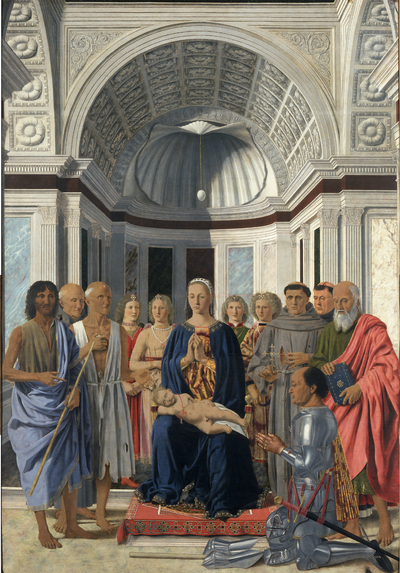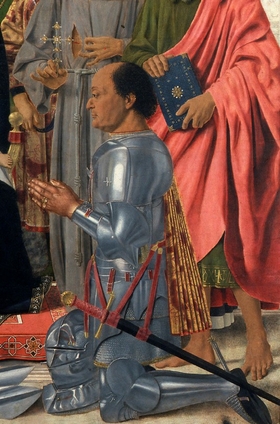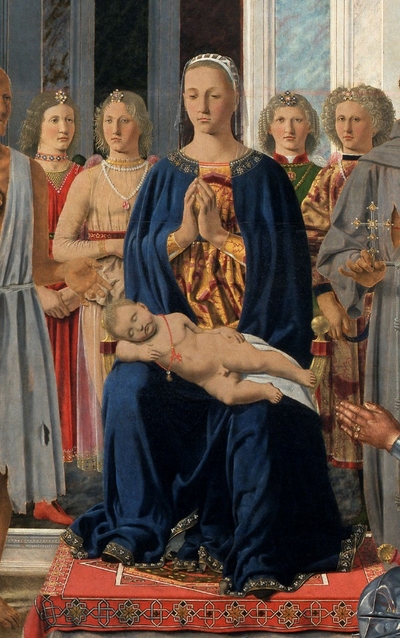Federico da Montefeltro, an esteemed but ruthless mercenary captain, a bastard child who became Duke of Urbino, a renowned humanist who turned little Urbino into a dazzling European court, also commissioned one of the most fascinating paintings of the 15th century.
 It goes by various names: "Madonna and Child With Saints, Angels and Federico da Montefeltro," the Montefeltro Altarpiece, the San Bernardino Altarpiece, and the Brera Altarpiece, a reference to its home at the Pinacoteca di Brera in Milan. By any name, the painting (1472-74), a tranquil view of Mary surrounded by saints and the man who paid for it, is sublime. Serene, sculptural, luminous, muted in color and masterly in its creation of an illusionistic space, the altarpiece crystallizes the extraordinary talents of its creator, Piero della Francesca.
It goes by various names: "Madonna and Child With Saints, Angels and Federico da Montefeltro," the Montefeltro Altarpiece, the San Bernardino Altarpiece, and the Brera Altarpiece, a reference to its home at the Pinacoteca di Brera in Milan. By any name, the painting (1472-74), a tranquil view of Mary surrounded by saints and the man who paid for it, is sublime. Serene, sculptural, luminous, muted in color and masterly in its creation of an illusionistic space, the altarpiece crystallizes the extraordinary talents of its creator, Piero della Francesca.
Piero (c. 1415/20-1492) came from Sansepolcro in Tuscany. Little is known about his early life, but he was certainly schooled in mathematics and he probably apprenticed with Antonio di Giovanni d'Anghiari, a local painter. He spent time in Florence, Rimini, Arezzo and a few other cities, interacting with major artists of the period. He arrived in Urbino for the first of many times in the 1450s, where, if he had already not done so, he saw works by Northern Renaissance masters and was taken by their beauty and naturalism. There, too, Federico became his most important patron.
Federico ordered the Brera altarpiece for one or more reasons. His beloved second wife, Battista Sforza, died in 1472, soon after the birth of their only son. He may have wanted to honor her, or the birth. And that year Federico, in his 50s, was also thinking about his next life. He had chosen for his mausoleum the church of San Bernardino, where this altarpiece was to reside.
 The painting epitomizes what is known as a "sacred conversation," a genre that originated in the first half of the 15th century and came to replace the traditional triptych or polyptych altarpiece. Sacred conversations depict Mary and Jesus, flanked by saints and sometimes by a donor, in a single architectural space. Despite the terminology, they are usually silent.
The painting epitomizes what is known as a "sacred conversation," a genre that originated in the first half of the 15th century and came to replace the traditional triptych or polyptych altarpiece. Sacred conversations depict Mary and Jesus, flanked by saints and sometimes by a donor, in a single architectural space. Despite the terminology, they are usually silent.
Sacred conversations are frequently set in a church's apse. But Piero places his figures at the intersection of the nave and transept, closer to viewers. The church itself takes up about half the painting, indicating its size.
Mary, gazing down at the sleeping Christ Child on her lap, occupies the painting's center. They are set on a platform that elevates them above the others. The saints, from left to right, are John the Baptist, Bernardino, Jerome, Francis of Assisi, Peter Martyr, and John the Evangelist. Federico would have chosen them—all martyrs or penitents—again, probably, with an eye on getting into heaven. Closer to Mary, behind the saints, are four archangels. The saints and angels all stand straight upright, echoing the vertical lines and marble panels of the architecture. Piero alternates a lighter figure against a darker panel, then vice versa, to create a certain rhythm.
Interrupting this verticality is Federico, kneeling. Though he is also upright, his sword and his arms raised in prayer create a diagonal that aligns with the slant of sleeping Jesus, further centering attention on him. Scholars have noted several aspects of Federico that stand out. He is near the holy figures in the painting, in contrast to the more usual stance of donors off to the side. His eyes fix on the sleeping Christ before him, rather than look upward in supplication. He is dressed in battle armor, not unprecedented but perhaps another indication that he is independent as well as pious. (One anomaly is not Piero's: Federico's hands, more realistic than the rest of the work, were overpainted by the Spanish painter Pedro Berruguete because Federico wanted to add a ring belonging to his wife.)
 Piero's harmonious scene is bedecked with symbols. His church is classical in design, which was associated with dignity. High above, the large shell, a popular motif in Roman architecture, represents purity. Jesus wears a red coral necklace, a common reference to his bloody death. The Oriental carpet, Mary's brocaded clothing, and the jewels she and the angels wear—especially the pearls, also correlated with purity—were high Renaissance fashion. Thus ennobled, they have no need for halos.
Piero's harmonious scene is bedecked with symbols. His church is classical in design, which was associated with dignity. High above, the large shell, a popular motif in Roman architecture, represents purity. Jesus wears a red coral necklace, a common reference to his bloody death. The Oriental carpet, Mary's brocaded clothing, and the jewels she and the angels wear—especially the pearls, also correlated with purity—were high Renaissance fashion. Thus ennobled, they have no need for halos.
Each saint is also easily identified. Francis parts a tear in his garment to display his stigmata; blood ripples down the forehead of Peter Martyr, who was killed by a blow to his head; John the Evangelist holds what is presumably the New Testament.
The egg hanging overhead has been much debated, with no conclusions. It may signify Mary's birth without original sin. It may symbolize fertility and motherhood, perhaps a reference to Federico's son. Or it may simply be an ostrich egg. They were collected in the Renaissance as rare treasures, and sometimes placed in churches as adornments.
This ethereal, meditative work is lighted from above and through an unseen window on the left, whose arch is reflected in the gleaming armor of Federico's left arm.
Although he lived almost another 20 years, the Brera altarpiece is one of Piero's last major works. He turned his attention to writing about painting, particularly about perspective and proportion. For centuries, in fact, he was forgotten. Only in the early 20th century was he recognized as a giant of the Renaissance. The Brera Altarpiece provided much of the evidence.

